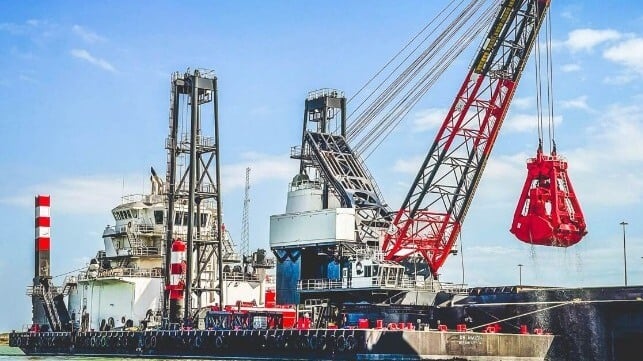Op-Ed: Time for Congress to Cut the Red Tape on Outdated Dredging Regs

President Trump’s recent executive orders mark a critical inflection point for U.S. infrastructure policy— especially for the dredging and marine construction sectors, which have long been strangled by outdated and burdensome regulations.
These three orders—the National Energy Emergency Declaration (January 2025), the 10-for-1 Deregulation Initiative, and Zero-Based Regulatory Budgeting for Energy—offer federal agencies both the authority and the mandate to modernize how they review infrastructure projects. That includes dredging, which is foundational to keeping America’s ports safe, navigable, and globally competitive.
Under the emergency declaration, the U.S. Army Corps of Engineers (USACE) is directed to expedite permitting, including maintenance dredging and channel deepening. The urgency is clear. Earlier this year, Brunswick Harbor in Georgia was passed over for routine maintenance dredging. That decision—despite its strategic and economic importance—sparked bipartisan concern. Georgia Senators Jon Ossoff and Raphael Warnock sent a joint letter to the Assistant Secretary of the Army and the USACE Chief of Engineers expressing “deep concern.” Rep. Mike Collins (R-GA), who chairs the House Subcommittee on Water Resources and Environment, has repeatedly voiced alarm over these kinds of delays.
This is not an isolated case. Regulatory chokepoints are becoming systemic. Last week, U.S. Transportation Command publicly released a report it sent to Congress on the Strategic Seaport Program, as required under the FY 2025 National Defense Authorization Act. USTRANSCOM is a unified, functional combatant command that supports the U.S. military’s global mobility by coordinating sea, air, and land logistics. Their findings confirmed what industry and port stakeholders have warned for years: limited dredged material disposal sites, overly complex permitting processes, and inefficient cost-sharing rules continue to constrain critical dredging operations. These aren’t engineering problems—they’re policy failures.
In Savannah, for example, environmental “dredge windows” based on outdated biological opinions limit dredging to just four months a year. These windows are not based on real-time environmental risk but on outdated models. The consequences are not just economic—they are strategic. Our designated strategic seaports must be reliably maintained to ensure military mobility. Narrow dredging windows, slow moving interagency coordination, and uncertain timelines undermine our readiness. Meanwhile, peer nations are modernizing their port infrastructure and deepening their harbors year-round. The United States cannot afford to fall behind due to self-inflicted bureaucratic bottlenecks.
The Biden and Trump administrations have both identified port modernization as a key national priority. The Infrastructure Investment and Jobs Act dedicated billions to coastal infrastructure and inland waterways. But funding alone isn’t enough. Projects can’t advance when permits stall for months—or years—due to fragmented oversight and inflexible rules.
The executive orders now in place provide a structure to move forward. The 10-for-1 deregulation policy calls for retiring outdated rules in exchange for any new proposal. The zero-based regulatory budgeting model shifts the presumption from "regulate unless exempted" to "review every rule from scratch unless justified." That shift is long overdue in a space where decades-old regulations still govern mission-critical activities. But agency action is still slow, burdened by court decisions that may take several years to unravel – and this leads to more studies.
What is needed now is implementation. Federal agencies—including USACE, NOAA’s National Marine Fisheries Service, and the U.S. Fish and Wildlife Service—can align their processes and timelines. Congress, too, has a role to play. Through oversight and appropriations, lawmakers can ensure that the intent behind recent executive and legislative directives translates into measurable legislative reform. One vehicle for this could be the National Defense Authorization Act for FY 2026.
Ports are not just economic engines; they are essential infrastructure for homeland defense, global trade, and disaster response. Dredging cannot remain a seasonal luxury or a bureaucratic afterthought. It must be treated as a continuous, strategic priority—year-round, across all coasts and waterways.
We’ve studied this long enough. We’ve held the conferences. We’ve heard the testimony. The policy tools now exist. It’s time to act.
William P. Doyle is CEO of the Dredging Contractors of America. He previously served as Executive Director of the Port of Baltimore and as a U.S. Federal Maritime Commissioner. A graduate of Massachusetts Maritime Academy and Widener University Commonwealth Law School, he is a licensed officer in the U.S. merchant marine and a member of the Marine Engineers’ Beneficial Association (AFL-CIO).
The opinions expressed herein are the author's and not necessarily those of The Maritime Executive.
